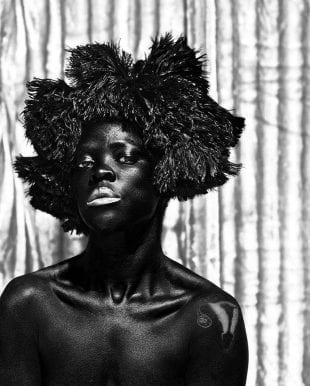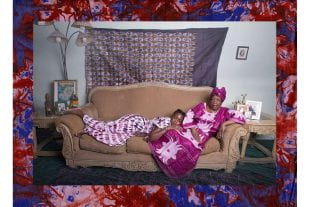Race, representation and the long-term effects of colonialization will be deliberated across three galleries — and, in one case, on the façade of the Moody Center for the Arts itself — as 10 contemporary African artists working across a range of media are showcased in next year’s spring exhibition at the Moody.

Omar Victor Diop,Jean-Baptiste Belley, 2014. Série Diaspora. Impression jet d’encre pigmentaire sur papier Harman By Hahnemuhle. © Omar Victor Diop. Courtesy Galerie MAGNIN-A, Paris
Alison Weaver, the Suzanne Deal Booth Executive Director of the Moody, announced this week that “Radical Revisionists: Contemporary African Artists Confronting Past and Present” will open Jan. 24, 2020, and run throughout the spring semester.
As Africa’s rich resources continue to be of great interest to powers around the globe, the selected works in “Radical Revisionists” will speak to the ways in which outside intervention during the colonial past and post-colonial present have deeply affected both its people and its natural resources.
“We look forward to engaging with these timely and provocative topics, concurrently with the university’s broader initiatives in the areas of African and African American studies,” Weaver said.
The arrival of “Radical Revisionists” on campus is intentionally opportune, scheduled to be on view during Houston’s FotoFest Biennial 2020. Opening in March, this year’s FotoFest theme is “African Cosmologies: Photography, Time, and the Other.”
The exhibition will also call attention to Rice’s newly formed Center for African and African American Studies, which formally launched in October.
Featured artists will include Sammy Baloji, Serge Attukwei Clottey, Njideka Akunyili Crosby, Omar Victor Diop, Adama Delphine Fawundu, Zanele Muholi, Robin Rhode, Yinka Shonibare CBE, Mary Sibande and Pascale Marthine Tayou. Featuring photography, mixed media, a virtual reality installation and sculpture, the show reconsiders Western narratives about Africa and its history and invites viewers to reexamine both past and present.

Faniswa, Seapoint, Cape Town, 2016. Gelatin silver print. CFaniswa, Seapoint, Cape Town, 2016. Gelatin silver print. Copyright Zanele Muholi. Courtesy of the artist, Yancey Richardson, New York, and Stevenson Cape Town / Johannesburg.
Concurrent with the exhibition, Rhode will be the Moody’s spring Leslie and Brad Bucher Artist-in-Residence. His work is informed by his youth in a newly post-apartheid South Africa and it includes elements of hip-hop, film and everyday materials. Rhode’s process often involves artistic interventions in public spaces, including interacting with his signature wall sketches as if they were three-dimensional objects. As the artist-in-residence, Rhode will spend several weeks in Houston, engaging with both the campus and the broader Houston community.
In the Central Gallery, the Moody will commission a new site-specific installation by Clottey, best known for his large-scale works that incorporate repurposed materials. Like Rhode, Clottey’s works also often involve participatory public performances. Reusing plastic gallon jugs that are commonly found across Africa, Clottey’s self-coined “Afrogallonism” work challenges viewers to consider the powerful agency of everyday objects as a vehicle for exploring issues of migration, colonial trade routes and gender stereotypes.
A virtual reality installation by Sibande will be presented in the Media Gallery. A multimedia artist living and working in Johannesburg, Sibande’s art often addresses the intersection of race, class and gender in post-apartheid South Africa. In “A Crescendo of Ecstasy,” Sibande activates sculptural forms through an immersive VR experience, blending fantasy with reality as viewers are invited into the enigmatic world of the artist’s alter ego.

Adama Delphine Fawundu, Passageways #3, Secrets, Traditions, Spoken and Unspoken Truths or Not, 2017. Archival pigment on paper. Courtesy of the artist
The Brown Foundation Gallery will feature photographs by Baloji, Diop, Fawundu, Muholi and Rhode, as well as sculptures by Shonibare and mixed media work by Tayou. A work by Crosby will be installed on the façade of the Moody building.
“Radical Revisionists” is co-curated by Weaver, associate curator Frauke V. Josenhans and independent scholar Rachel Kabukala.
“’Radical Revisionists’ invites us to acknowledge and investigate our shared colonial past through the work of influential artists who are addressing the violent erasure of marginalized histories and reinterpreting familiar themes through contemporary, Afrocentric lenses,” Kabukala said.
“Radical Revisionists: Contemporary African Artists Confronting Past and Present” will open Jan. 24, 2020, with a free public reception from 6-8 p.m. It will be on view through May 16. Additional programs featuring dance, music, film screenings and panel discussions between artists and historians will be scheduled throughout the season. For more information, visit moody.rice.edu/upcoming.

